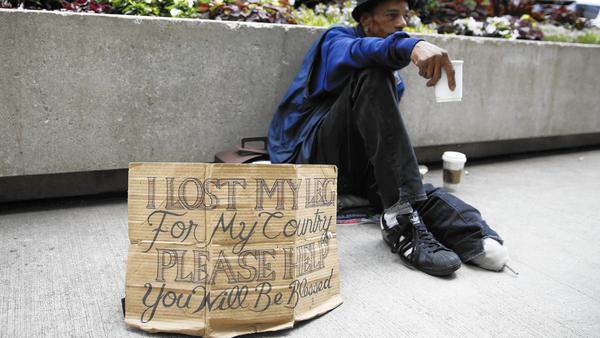
Jasper Craven
Among the tall towers and tourists crowding Chicago’s Magnificent Mile is an often overlooked population: homeless people with signs asking for change.
While many of the cardboard signs seem hastily scribbled, over the past months many of them have been revamped and replaced, a project from a Chicago art student who hoped that beautiful lettering would stand out amid the hustle and bustle of Michigan Avenue.
“My hope was that the Chicago project would create some awareness around the homeless,” said Ian Todd, the man behind the hand-lettered signs. “And also that people would be more inclined to talk when they walk by, and more willing to give.”
When Ian Todd moved to Chicago from a small town, the first thing that struck him was the amount of homeless people on the city’s streets. In an effort to help, he began redesigning their signs as an art project. June 30, 2015. (WGN TV)
Todd, 23, said Wednesday that he was struck by the vast number of Chicago’s homeless when he moved to the city from California to study at the Chicago Portfolio School, which focuses on advertising and design.
“It was a bit shocking seeing all the homelessness,” he said. “I was taking a class on expressive type, and after seeing someone hold a cardboard sign I thought a well-designed one could grab people’s attention.”
Todd first approached homeless people in April, asking whether they wanted new signs. Some refused, but others acquiesced and Todd got to work. He finished about 20 signs in two months and said that the complexity of the lettering meant one sign took anywhere from five to 10 hours to complete. He started a blog called “The Urban Type Experiment” documenting his experience making the signs, which quickly went viral.
The signs, all of which are photographed on his blog, tell varying stories of turmoil, from a single father struggling to support three children to a woman offering work so that she can afford a bus ticket home. Todd kept in touch with many of the sign recipients and said while some had success, not all of the signs brought an uptick in charity.
Mike Droney, 54, was holding one of Todd’s signs on Michigan Avenue on a recent sunny afternoon. The aging piece of cardboard read: “I lost my leg for my country. Please help, you will be blessed.”
Droney, who has been homeless for six years, said he lost his leg fighting in Somalia. He sits in front of a Starbucks coffee shop most days asking for money, and said the only real assistance he gets is medical care from the Department of Veterans Affairs.
Droney said he often gets accolades about the sign, but it is hard to quantify whether the lettering is really doing much.
“People compliment me on it, you know, so it might help, in a way,” he said. “I can’t really say.”
Ulysses White, 54, also has one of Todd’s signs and said it has resulted in more charity. White said he served two tours in Iraq, and his sign makes mention of his service before saying: “Anything is appreciated. Thank you for your generosity.”
White got his customized piece of cardboard after being introduced to Todd by one of his homeless friends who already had a sign.
“The new sign has helped, most definitely, a whole lot,” White said. “He made signs for a whole bunch of people along Michigan Avenue.”
Todd’s project is not the first of its kind; in 2011 the Tribune profiled Christopher Devine, who was printing and laminating signs for the homeless. Devine’s signs were much simpler than Todd’s, printed on white paper in bold Helvetica font with text declaring “Homeless” or “Please Help.”
Devine, 32, said Thursday that he printed nearly 700 signs over the past four years of the project and just stopped distributing signs a few months ago. He said he has seen Todd’s artwork on the street and was happy to see another project aimed at increasing the visibility of the homeless population.
“They are far more elaborate and intricate than the plain Helvetica signs, they are eye-catching,” he said. “The important part of both projects is that the signs are different aesthetically than your typical homeless sign.”
While Devine’s project got mixed reactions, including some who said the signs denigrated the homeless, Devine said the project was successful in his eyes. He said a flood of donations came in following the story to help cover his laminating costs.
“There were a number of people who were against the concept of the project,” he said. “The point is, yesterday they weren’t talking about homelessness, and today they are.”
Ed Shurna, executive director of the Chicago Coalition for the Homeless, said that while the revamped signs may help some in the homeless community, Chicago’s homeless problem requires systematic action. He said the homeless population is the largest in recent memory, adding that 6,000 people fill the city’s shelters each night.
“It’s getting worse, is all I can say,” Shurna said. “You see more people on Lower Wacker, more people on the lakefront, it’s escalating.”
Shurna said that Gov. Bruce Rauner’s budget priorities would reduce care services for poor people and exacerbate the problem of homelessness throughout Illinois.
“If the cuts being proposed at the state level continue, you are going to see shelters closing,” Shurna said. “There is going to be a big increase in homelessness, and even now the shelters aren’t sufficient.”
Todd, who just graduated from the Chicago design school in May, moved to Los Angeles a few weeks ago to begin an advertising internship. He said he notified his homeless friends before he left that he would no longer be able to make signs for them. While he said his new job keeps him busier than when he was in school, he didn’t rule out making signs for California’s homeless.
“Homelessness is definitely here,” Todd said. “I wouldn’t mind getting something started.”
